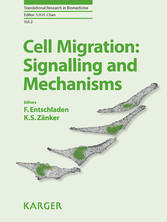Suchen und Finden
Cover
1
Contents
6
Foreword
7
Preface
9
The Migrating Cell
10
Abstract
10
Acknowledgement
14
References
14
Stem Cell Migration in Health and Disease
16
Abstract
16
HSC/HSPC Mobilization
19
HSC/HSPC Homing
21
The SDF-1a/CXCR4 Axis
23
Modulation of the SDF-1a-Induced Migration of HSPCs
26
Cancer Stem Cell Migration
27
Conclusion
30
Acknowledgements
31
References
31
Leukocyte Motility and Human Disease
37
Abstract
37
Basic Steps of Cell Movement
37
External Factors That Regulate Cell Migration
38
Cell Signaling during Neutrophil-Directed Migration
38
Neutrophil Motility in Disease
43
Neutrophil Motility in Chronic Inflammatory Disease
44
Conclusion
45
References
46
Coordination of Leukocyte Polarity and Migration
49
Abstract
49
Leukocyte Polarization
49
Sensing Chemotactic Gradients
52
Establishment of Two Poles: Front-Back Coordination
54
Microtubule Connection: The Lost Link?
56
Segregated Signalling Domains in Polarized Lymphocytes
58
Concluding Remarks
60
References
60
Positioning Phosphoinositide 3-Kinase in Chemokine and Antigen-Dependent T-Lymphocyte Navigation Mechanisms
63
Abstract
63
Class 1 PI3Ks: An Overview
64
A Role for PI3K in Cell Migration: The Story So Far
65
Evidence for PI3K-Dependent and -Independent T-Lymphocyte Directional Migration
66
Role of PI3K in T-Lymphocyte Homing and Migration in vivo: Lessons from Gene-Targeted from Mice
67
Role of PI3K in Interstitial T-Lymphocyte Motility
68
Antigen Recognition by the TCR and Costimulatory Receptors Influence T-Cell Trafficking
68
PI3K Influences Effector T-Cell Migration at Transcriptional and Post-Translational Levels
70
Conclusions
70
Acknowledgement
72
References
72
Migration of Functionally Specialized T-Helper Cells: TFH Cells, Th17 Cells and FoxP3+ T Cells
76
Abstract
76
Migration and Trafficking Receptors of T Cells
77
Generation of the Functionally Specialized T-Helper Cell Subsets
78
Migration and Function of TFH Cells
79
Migration and Function of Th17 Cells
82
Migration and Function of FoxP3+ Cells
84
Concluding Remarks
85
References
86
ADAMs and Ectodomain Proteolytic Shedding in Leukocyte and Tumour Cell Migration
92
Abstract
92
Leukocyte Trafficking
93
ADAMs and Ectodomain Shedding of Leukocyte Receptors
95
CD44 Shedding and T-Cell Recruitment in Autoimmune Lesions
100
ADAMs and Ectodomain Shedding of Endothelial Receptors
100
Crossing the Basement Membrane and Interstitial Migration
101
ADAMs and Ectodomain Shedding in Tumour Cell Extravasation
102
How, Where and When Are ADAMs Activated
102
Regulation of ADAM10 and 17 Proteolytic Activity
103
Regulation of ADAM15 Function by Interacting Kinases
104
Conclusions and Future Prospects
105
References
106
Guided Tour of Cell Migration: Signals and Pathways
111
Abstract
111
Induction of Migratory Activity by Extracellular Signal Substances
112
Pathways Leading to Cell Migration (Cytokines and Neurotransmitters)
118
Conclusion
123
Acknowledgement
123
References
123
Regulation of the E-Cadherin Adhesion Complex in Tumor Cell Migration and Invasion
129
Abstract
129
E-Cadherin-Mediated Adherens Junctions
130
Regulation of E-Cadherin Gene Expression
131
Regulation of the E-Cadherin Adhesion Complex by ß-Catenin
134
Regulation of Cell-Cell Adhesion by the Cellular Microenvironment
136
Regulation of Cell-Cell Adhesion by p120ctn and GTPases
138
References
140
The Cytoskeletal Connection: Understanding Adaptor Proteins
145
Abstract
145
The Cell Adhesion Complex: A Simplistic View
145
Proteins: Biochemical Characteristics and Molecular Architecture
147
Cell Adhesion Complex: Protein Properties in the Cellular Context
150
Cell Migration: Regulation of Adaptor Proteins during Contact Turnover
156
Organism: Specific Tasks in Tissues and Organs
164
Concluding Remarks
165
Acknowledgements
166
References
166
Locomotor Force Generation by Myosins
172
Abstract
172
The Myosin Superfamily
172
Myosin I
175
Myosin II
175
Myosin V
176
Myosin VI
178
Myosin VII
178
Myosin X
178
Concluding Remarks
179
Acknowledgement
179
References
179
Author Index
182
Subject Index
183
Alle Preise verstehen sich inklusive der gesetzlichen MwSt.










